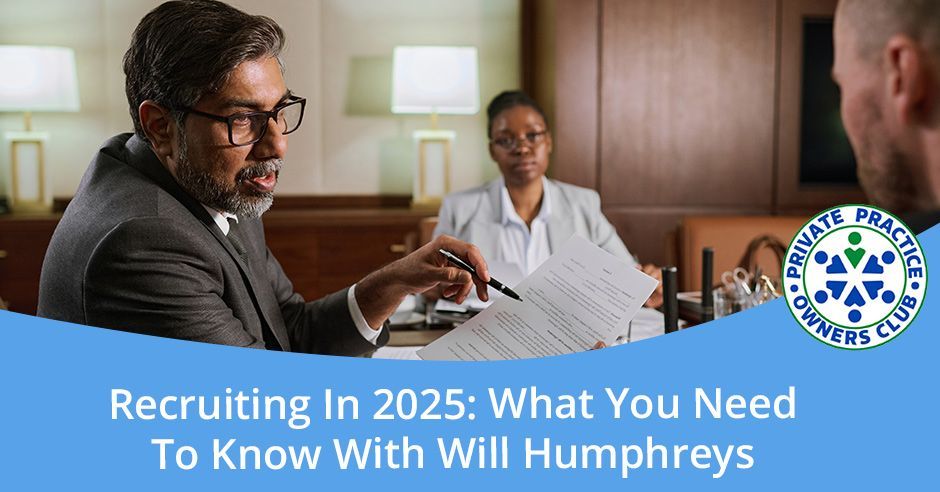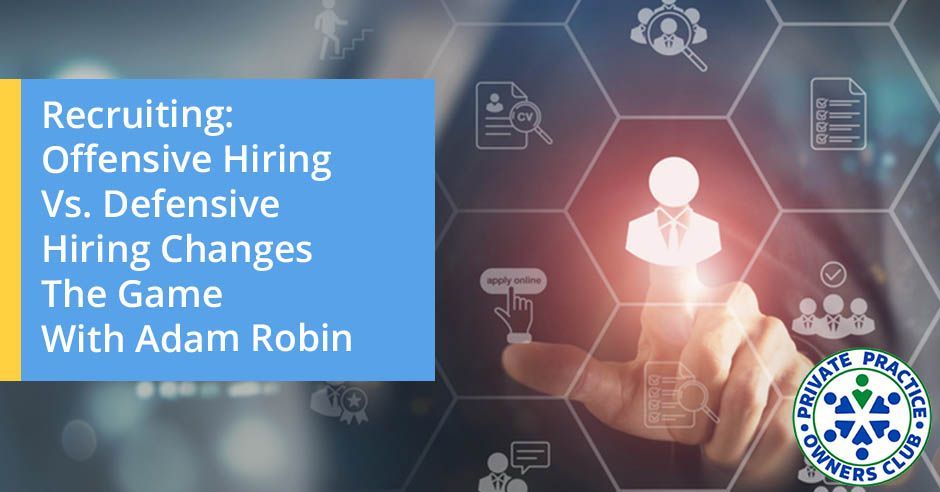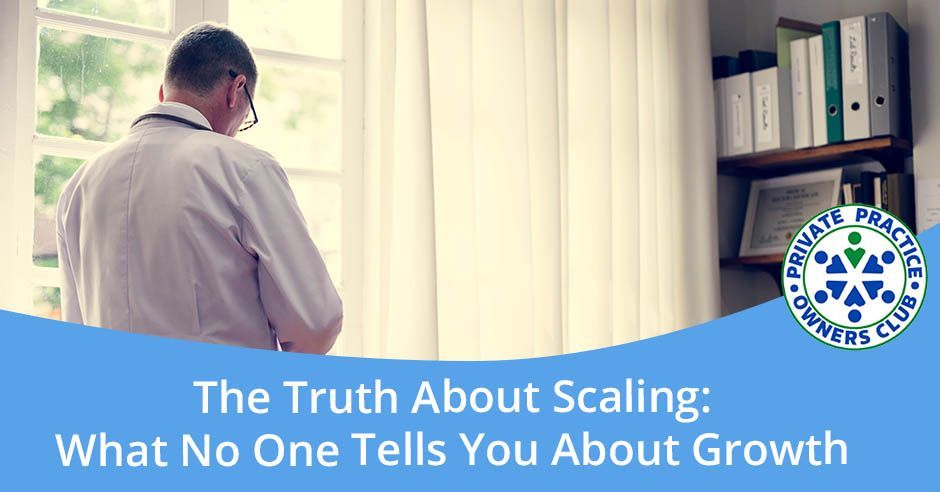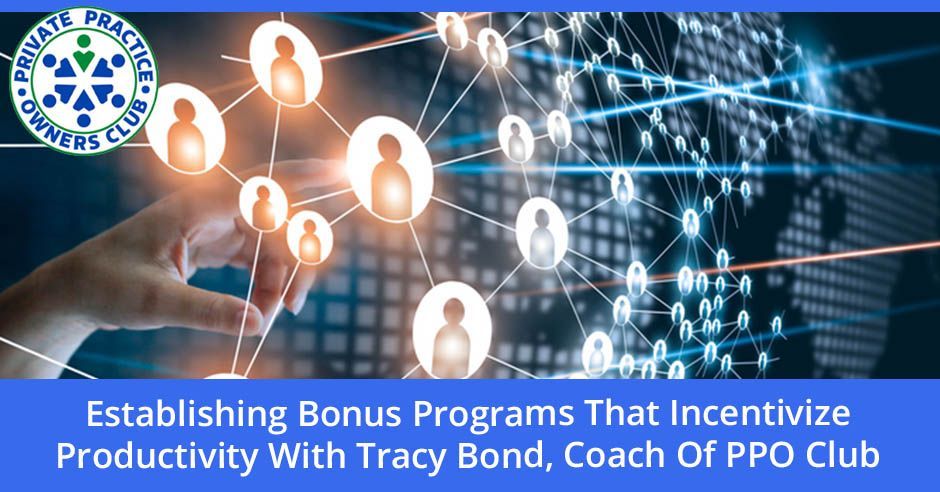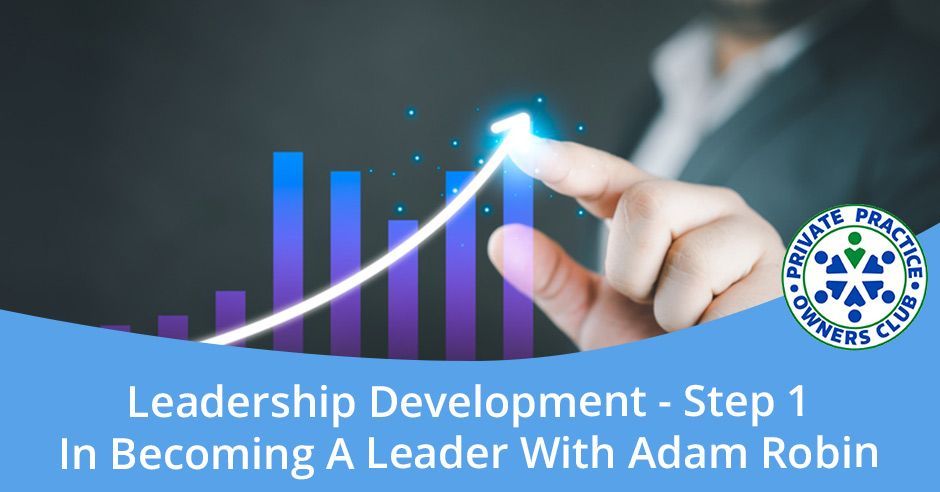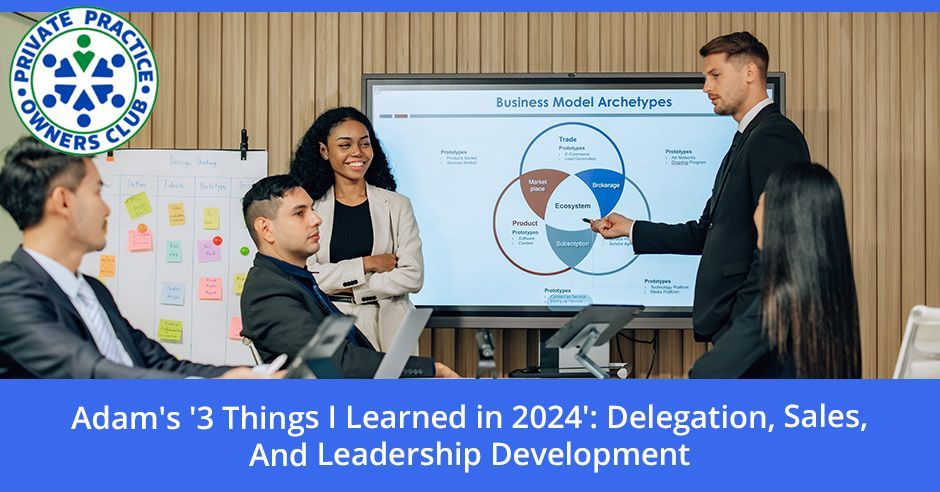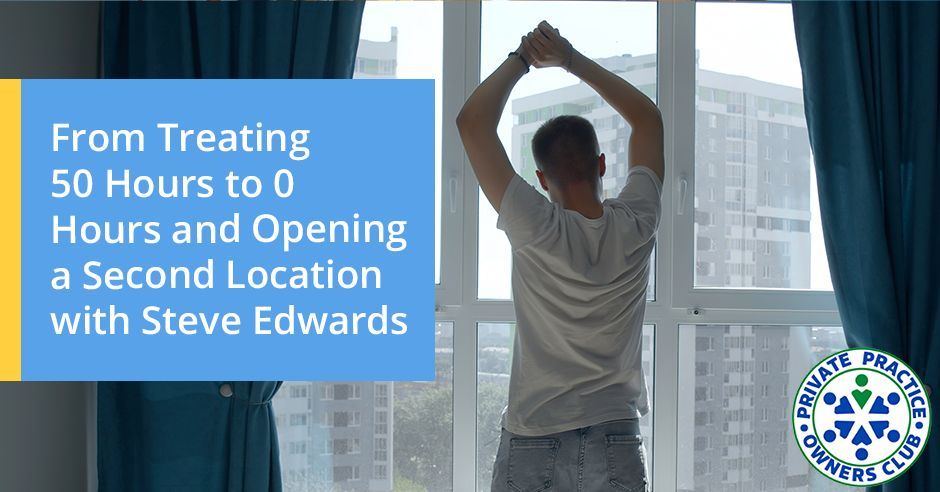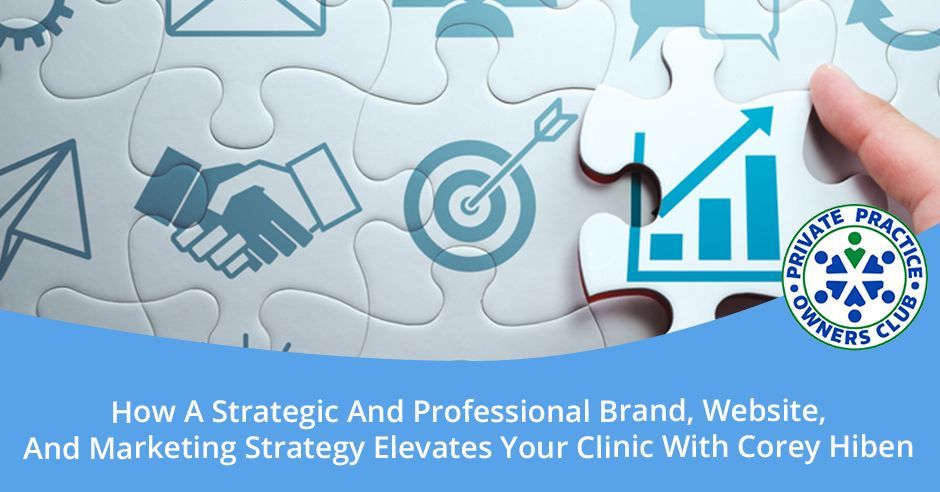Creating A Comprehensive Marketing Strategy Is A MUST For New Patient Growth – Facebook Live Intervention With Nathan Shields And Adam Robin
One of the weaknesses of PT owners is the development of a clear Marketing Strategy. Some of the components of a proper Marketing Strategy include answering the following questions: Who is the ideal client? What is the message to them? What do they need to know about you? Where would they hear about you? In this episode, we break down the development of a marketing strategy with Cliff Wonsettler, PT of Wonsettler PT so he can target areas of his clinic where his marketing is weak and how a more comprehensive strategy will net him more new patients immediately. From targeting and attracting the “right clients” to gaining internal referrals, we leave no stone unturned. Learn how to convey what potential patients need to know about your practice and where to effectively reach them. Tune in now to supercharge your marketing efforts and propel your clinic to new heights of success.
—
Listen to the podcast here
Creating A Comprehensive Marketing Strategy Is A MUST For New Patient Growth – Facebook Live Intervention With Nathan Shields And Adam Robin
What we’re going to be talking about today is applicable to almost all outpatient clinics. I don’t know who wouldn’t benefit from this, but one of the weaknesses of most PT owners is what we’re going to talk about. That is building out a marketing strategy , and looking at it in terms of structure and how to apply the appropriate energy and money to the various possibilities that we have out there. Let’s get into it. Cliff, you have had a relatively new clinic over the past couple of years in Pennsylvania, just outside of Pittsburgh. You have built an amazing new home . Y ou have a beautiful young family and all those good things. To cut to the chase, what are you dealing with right now in your clinic that is a “marketing issue?”
The departure for us is our internal marketing manager. I hired a person who was just out of college. It was a little over two years ago now. I hired him. I knew from the start it was going to be a hybrid role because we’re still in the startup mentality at least. We’ve grown a lot. We’ve had ten physical therapists that work for us. We’re still in this entrepreneurial startup phase, at least in my mind. We needed to have some people do different things, play different roles, and wear different hats.
I hired him to do some front desk things initially and also to do some organic posting and content creation. He was just out of college, but through college and even into high school, he was a professional photographer and getting paid to do various things. Not just weddings. He’s a good photographer. He’s got a creative side. He would do well at least in parts with our social efforts and that kind of thing. Anyway, he stepped into that role. He’s done a great job. His role has certainly evolved and changed.
He hadn’t worked at the front desk any longer, but he gave me notice about 3 or 4 weeks ago that his last day is this upcoming Wednesday. We have a little less than a week of his time left until he moves on to something else, which I’m excited for him to do. I think it’s going to be a good thing for him and a good move. Regardless, we’re in a situation now where we’re trying to reconceptualize our marketing strategy and our marketing efforts and understand that this is an opportunity for us to do things differently and become more effective at what our intention is, which is to draw the right people to us and have them understand how we can help them.
That’s where I’m at. I’ve worked through some of this thing, although I’m excited to hear your perspective. We’re going back to the drawing board and thinking about what it is, what our order strategy has been, what the function and the idea behind our strategy, and how we can then leverage what we’ve done well in the past but also look for new ways to become more effective at our strategy.
Adam, I’m going to turn it over to you here in just a second because I know you want to get started and jump into it. Let me first congratulate you on hiring a marketing person from the get-go. For those who don’t know Cliff, he’s a young practice owner who’s not practicing in his clinic full-time or much at all.
I haven’t seen a patient in probably five months or something like that.
I think a lot of that is mindset. This is a smart guy. He’s got a great business mindset but also, you had a marketing person before you opened your doors.
Yeah, we had.
How rare is that? I haven’t heard of it. I think that’s a tribute to your success. You have a number of providers already. You’ve got a decent patient load. You have a steady clinic. I think part of it is because you were forward-thinking enough to say, “I’m going to hire a marketing person first and get some people in the door.” I also congratulate you on taking the opportunity here to not just shelve your marketing systems for now until you find the right person, but to reach out and be willing to talk to us about, “Where should I start?” Have you ever had any consulting or coaching on a marketing program?
Just to take a step back from what you were saying, I didn’t hire this person. He was maybe hired about two years into our business being opened. For the year, we were going through a big build-out right out the gate. We built a 5,000-square-foot building. This was our first clinic, which was a risky business, but thank God it worked out regardless. As construction was going on for about a year, I consulted with an independent marketing consultant who helped me rethink how to tell a story and how to attract the right patients. He was immensely helpful in that whole getting out-of-the-gate phase. I worked with him in that same role for about a year after we had opened.
It wasn’t necessarily this guy who put in his notice, but you hired a marketing consultant a year prior to opening, which kudos to you. That’s great. I wish more people would do that. Adam, where do you want to start on this?
I don’t know. I think I would like to just start with a few questions if that’s all right. Cliff, I could be wrong, but I get a sense that you have somewhat of an idea of what your ideal scene looks like. Maybe you don’t have all the specifics and the operations all built out, but if you can dream with me for a second, let’s pretend like we got all that figured out. What would the ideal scene for you look like?
From a marketing strategy?
From a marketing standpoint. Tell me more about that. What’s your vision? Share that with me.
This has been my vision from the jump. The reason why I wanted that consultant to help me out early on was even prior to opening, I was managing a private practice in Seattle prior to moving back to Pennsylvania and starting this practice. Even in that role, it never seemed to make sense to me why the only employed strategy in that company at the time was to market ourselves or our services to doctors’ offices, surgeons, PCPs, rheumatologists, etc. I’m not saying that it should not be a component of a marketing strategy. Truthfully, from some perspective on that, I didn’t step foot into a doctor’s office as the representative of one set of physical therapy until we were open for about two and a half years.
That was not like I was above and beyond. I didn’t have the mentality that I was better than thou or that was not something that I felt could be beneficial. Marketing directly to the people who should be making the decisions, which is the patient, was always something that made very common sense to me. I feel like, at least from the physical therapy world perspective, that’s not as common of a strategy as it should be. That’s just my opinion.
I think that’s changing. If I could try to describe in a nutshell what I would want to happen and what we’ve tried to work at up to this point, it’s to use mediums that make sense for the people who are most receptive to the help that we can provide, find those people, and talk to them in ways that make sense to them through mediums that make sense to them. Also, help them understand how we can solve their problems. Most of our efforts up to this point have been within that lane.

I don’t disagree with you . I’m just interested. Why do you feel so strongly? You have a passion, maybe that’s not the right word, but you have some strong thoughts or opinions about why marketing directly to the patients is important. Why?
The why would be that they are the person that is going to receive the service. They’re the people that need our help. It’s not like doctors don’t need referral sources for physical therapy when they have a patient who is indicative and such. The people that we’re trying to serve are the patients at the end of the day. They are our customers. Those are the people that we should care more about than anyone else.
Talking directly to them before they were ever an actual patient of ours through marketing efforts and through a lot of different ways is the why for me. I want to understand their biggest worries, fears, obstacles, and concerns. I want to understand what they’re chasing after and what their ambitions, intentions, and goals are. What better way to find that out than to ask, speak, and engage with them around those questions and concerns?
I don’t feel like a good strategy in terms of finding out what patients need is hearing from the doctors on that. Not that they don’t have something, just like you guys wouldn’t have something to offer. You have insights. You’ve worked with a lot of patients. Obviously, our physicians have too. We see things differently than a patient and that’s how it goes. I wanted to have answers to those questions so that I could more confidently speak to our ability to be able to deliver on the promise that I am confident in our ability to do so. In order to be able to communicate that effectively, I knew I needed to ask the right questions and engage in the right ways.
W hat you’re saying is you know who your ideal client is. You have that avatar built out. In order to find those persons, you are strategically looking for their watering holes. Where do they congregate? Where do they exist? Also, what are their concerns and what are they hoping to see in their physical therapy clinic? The cascade that happens from there is if you know your ideal client, you can speak to them, and then you can capture them, then you’re already aligned. They’re going to more likely know, like, and trust you, and then they’re going to be more likely to refer friends and family after that. It starts at the top. You have to know who your ideal client is, speak to them, and then all those things fall into place.

That’s exactly right. A good story about that. Something we do in our clinic is before anybody gets on the schedule, they talk to a physical therapist on the phone prior to being scheduled for their evaluation. I used to handle 100% of those calls. Now, I handle very few and far between, but I’ll occasionally do one. Our front desk said, “This doctor who’s 3 pounds over wants to become a patient.”
She has this issue. I’ve never met her. I’ve seen her name come across. I’ve never been into her office either. She’s had so much positive feedback from her patients going back to her and saying, “These people are amazing.” When she had an issue, she called us. That’s a testament to exactly what you were saying, which is to let the people who are receiving the service be an advocate and a megaphone for your message and your strategy. It’s part of it.
You did mention fears, worries, obstacles, and ambitions. Do you know what they are?
I think it’s different for every single person. There are overlapping themes that we see with our patients. I know you guys know that too. If we want to talk specifics, the fears in blanket terms are always related to the worry of the future of what if and then fill in the blank negative. What if I can’t X, Y, or Z? What if I can’t? It’s always around what might be taken away from somebody in terms of their freedom to do what they want to do, to live life on their own terms the way they see it, the way they want to see it, the way they want to be, and who they want to be in terms of their physical capabilities and their freedom to move.
Our ability, whether it’s on the phone before they’re ever on the schedule and throughout the evaluation, and every subsequent visit until they’ve climbed their mountain is to understand more deeply what that specific fear is for that individual. Once we uncover it, we all know and you guys know this. Once we get to the bottom of it, we start peeling back the layers of the onion because initially, they say something like, “I just want my neck pain to go away.” What would that look like for you? “It would mean that I wouldn’t have all these difficulties sitting at my desk all day when I’m typing at work.” “Tell me more,” and just keep digging on that.
They then finally say something where there’s energy, concern, and authenticity around their response because they finally say something like, “What I want to be able to do is play in this adult league baseball because that’s my only social outlet. It’s the only time I ever get out and see my friends. If I can’t do that, I’m going to be sad. I’m going to be bummed out.” Whatever they say. There’s a million different things out there. Once we uncover and discover what that is, that’s the essence of what we then can use to intervene and to get back to.
You also mentioned using mediums, channels of communication , common-place , or watering holes. Call it wh at ever. Where do these people hang out? Do you have those? Do you know where they’re at?
I think so. Nathan earlier mentioned avatars. We’ve got three different avatars. We’ve got a Donna, a John, and a Nikki.
They ‘ve got names for each. That’s awesome.
They’ve got names. I know their kids’ names. I know how much income they have. I know how many grandkids they have. Our team knows that too. As I say, my team knows that. Frankly, I bet we’ve probably hired three or so people in the last six months who haven’t heard directly from me what our avatar’s names are and what they’re all about. There’s an opportunity for us to be able to reengage with something that we’ve shared with some that have been shared with others.
That’s a general blanket issue that I have. I’m not a good manager. I think I can see some of the future. I get excited and pulled into that, but I have a difficult time returning back to the present day or even looking back and saying, “What could have been better here?” Managing to an expectation and coaching people up. That’s not what we’re talking about. What we’re talking about is avatars and communicating those things.
Yo u know where they’re at .
You got to know where they’re at because our one avatar, Nikki, is a 30-something-year-old CrossFit athlete. Not to get specifics on Nikki and what her avatar is exactly, but where she’s getting information and who she’s getting information from is much different than another avatar, John, who’s 78 years old and has Parkinson’s and several different aspects of his life. How he’s consuming information, media, and his circles are all different. Just the demographics of our particular office, between 40% and 45% of our caseload is 60 to 65-plus. It’s a high Medicare population.
One of our strategies, and we’ve been doing this for the last at least two years, is utilizing the radio and newspapers. I would’ve never thought that would’ve been part of what we would have done initially because I thought, “That’s a dinosaur medium. It’s on its way out. Why would we invest and spend money and effort doing that on those mediums?” We try as best we can to track precisely our referrals, our leads, our conversions, and where those people are coming from.
We do things on social media through Instagram, Facebook, and some YouTube as well. I understand also that most people are maybe more inclined to say that they’ve heard about you through something other than social media because a lot of people don’t like to admit that they’ve been influenced in that manner. We ask directly, “How have you heard about us?” They say, “My cousin or my sibling went there.” They mentioned 1 or 2 names of some word-of-mouth referrals that suggested that they come to us. We asked also, “Have you heard about us through anything else, like Facebook, Instagram, the newspaper, or the radio?” Invariably, when people respond to one of those categories, the radio and the newspaper outperform our digital responses.
No way. That’s crazy.
Yeah. It’s like 2 to 1. It’s substantial. Again, it’s something that’s our demographic, but we got to know where people are at. If you know your avatar, which is the other avatar, Donna, is late 50s. She has a couple of adult kids. It’s not uncommon for her to listen to the oldies station on the way to work either, to pick up the newspaper, or at least read it online digitally.
She’s not afraid to do that.
No.
I f you were to tell me that you’re still doing Y ellow P age ads, that would blow my mind.
Craigslist.
I think it’s an important thing. We’re constantly looking at that, but I’ve seen no indication that it’s not continuing to bear real fruit for us and be healthy and productive in terms of our ability to be able to story tell and attract the right people.
I think what’s clear is you are a few steps ahead of what I would say most owners when it comes to a marketing strategy. It starts with, “What is your avatar? Who’s your ideal client?” You have all the nuts and bolts around that. What is their insurance? How much money do they make? What does their family situation look like? What are they dealing with at home? Also knowing a little bit about where their social circles are and how you’re going to find them. That’s a big part of the beginnings of your marketing strategy.
It sounds like you’re very clear on your avatar and your messaging. You’re also clear on the water holes, and you’re also clear on what’s working for you.
We’re gaining clarity.
It is a moving target.
We’re all gaining clarity. W hat is stopping you from taking massive action today ? Why the hesitation? Why not just take the knowledge that you have and go full speed?
My hesitation up to this point, which we’ve finally gotten to where we’ve got clarity on a decision. I know we’ve got clarity on a decision and we’ve got direction on how to move forward. My hesitation after the marketing guy internally had given notice was whether or not we tried to outsource a decent haul or a decent amount of that work or try to bring somebody in-house like we have been doing.
Do you replace this guy with another person or do you outsource it?
That’s right.
That’s the real question .
That was the big question for me.
That’s the big holdup.
Finally, after chewing on it, I decided to outsource. I’ll tell you why. I mentioned this earlier in the conversation, but we’ve only got fifteen employees. Ten of those on the payroll are physical therapists. Evan, the internal marketing guy who’s not just wearing the marketing hat, even up to this point, does some miscellaneous tech help. Occasionally, if we’ve got a front desk person who’s off for the day, he’ll step into that role. It’s not common, but he needs to know how to do that role. He helps us with our tech support or with our EMR. He does some data management for us.
He was wearing a lot of different hats. Frankly, it’s foolish for me to expect that anybody could be excellent at all on those different tasks. His ability to deliver on the marketing side was continually improving. He was making progress. I hired him as a copywriting and content strategy coach to help not only coach him but also coach me. I was at every single meeting with the coach or the consultant. That consultant helped Evan come up in terms of his ability to be clear and be a more effective communicator, and the look and feel of things. Just a lot of different aspects of our deployed strategies were improved by Mike, which is his name.
There were certain aspects of the marketing role that Evan was playing that did not come naturally to him or were a challenge to continue. Again, there’s no way that he could be excellent at all of those things. In deciding or trying to determine what is the best course of action for us at this moment, understand that if you’re going to get excellent, you need to have somebody who’s already doing to some degree excellent work in that area. That’s not to say that they’re not always improving and growing, and they can’t be coached and they should be coached.
Understand that if you're going to get excellence, you need to have somebody who’s already doing excellent work in that area to some degree.
Click To Tweet
For us, the decision is to not replace Evan and to outsource with the same consulting coach I was telling you about before, Mike. He’s going to essentially now take a fractional CMO role within our company, overhaul our strategy, and reconceptualize what is our strategy and how we’re going to do it. He’s the same consultant that I worked with for a year prior to opening.
You have a history.
We have a history. I’ve worked with him for six years, not continuously. I worked with him for about a year and a half to maybe a two-year period, and then we took a couple of years off because I feel like we flatlined in terms of what he was expecting me to do. At the time, I didn’t have an internal lead dedicated marketing person who could execute a strategy. I was still treating patients and doing everything else that an owner does.
With my ability to be able to leverage the advice he was giving and reach the ceiling, I re-engaged with him after we had hired Evan and given him the marketing management position, roles, and responsibilities. The decision to outsource to Mike and to bring him on as a fractional CMO became much more clear and apparent that was the right strategy, at least for now, to employ. That way, he can reconceptualize how we’re doing, what we’re doing, and figure out more clearly what’s working, what’s not, how to think outside of the box in terms of generating high-quality leads that are going to become patients that are just raving about what we do and how we do it.
Related to that, I can see where you’re coming from. You have the choice of either finding someone who might have some marketing experience, and then you’d have to go through the pain and energy to train them and coach them on how we do things at one settler, and these are our systems. There are some benefits to that, but there’s also a huge benefit to having an “expert” come in and provide their expertise right off the bat. You’re using him fractionally, so part-time, a few hours a week to stay on top of all your marketing systems that are currently existing. Maybe edit some of those , move them around, and improve them.
There’s a huge benefit to them. For the people who are tuning in and I don’t want to go down this tangent too far, but if they were thinking, “I would love to have a fractional CMO. I would love to have a part-time or hourly Chief Marketing Officer on my team who is an expert.” How did you find yours? Just in case people are able to look for those, where did you find yours?
Having that history and working with him in a consulting role was the first step for me. The fact that you mentioned this on the patient and provider aspect, but know, like, and trust him that he is a capable and skilled marketing visionary.
Where did you find him back in the day?
It was just a referral. It was a referral from a friend who is in electrical contracting. He had known this guy. I told him, “I would love to find somebody who can help me out with marketing strategy.”
You used your network.
That’s it.
You used your network of other entrepreneurs and business people . You’re like, “Who do you know out there that knows how to market well?” It helps that your friend could vouch for him instead of being like, “My daughter just graduated with a marketing degree.” That’s not necessarily what you’re looking for when we’re talking about expertise. Who do you know that’s in the business and has done it well at other places and can be vouched for ? Utilizing your network is cool.
I haven’t even mentioned the other. We’ve worked for the last probably 2.5 to 3 years with a different marketing consulting company too, who mostly places our ads. They’ve built a relationship with the radio station and with the newspaper. They manage all of that for us. They don’t necessarily provide a whole lot of high-level strategy, though I think they do have that capability within their team. The way in which we’ve used them is what I just described, but it’s the same deal. You asked the question of how do you find them or how did I find that other consulting group. It was also within my network.
A family friend of ours is in the later stages of his career, but he has been in banking forever. He was the CEO of a somewhat small local bank. I reached out to him. He took on a mentorship role with me. We had first opened. I told him, “I feel like we’ve flat-lined in our marketing efforts after the first year or so of being open. He connected me to a guy who has been a tremendous asset for us too.
You have a mentor . Y ou used your network. These people plugged you in and found people that you can trust to take over your marketing. Also, because many PT owners don’t have this number, you don’t have to give me a specific number, but it’s hard for them to take action, especially as they talk to vendors . T he first question that a vendor is going to ask is, “What’s your budget?” It’s d eer in the headlights for most PT owners. They’re like, “I don’t know. I was hoping you would tell me.” As a percentage of your gross revenues, do you have an idea of what your marketing budget is just so people have an idea?
I’m a little less than 10%, I think. Maybe 7% to 8%, or something in that range.
That sounds about right.
It could be as low as 6%.
Would you say that’s about the same for you, Adam, or are you a little bit less?
As you said, 7% to 8% is a good goal, but for a long-term goal, we want to try to get that down to 5% or 6%.
As you’re starting a new clinic, maybe that bumps up to 8 % , 9 % , or 10 % .
Or i f you’re starting a new program, or if you’re starting something new, hire an OT or a speech therapist or something.
Temporarily.
To have a new avatar that’s built, you might have to bump it up.
I don’t mind sharing specifics though. One thing to that is every clinic is different. Every owner is different. In every approach, there are nuances based on your area and all of that. The only money that we had spent for the first two-plus years of being open was that marketing consultant fee, which he charged me $1,000 a month. We met 1 to 2 times a month for a couple of hours. It was just coaching. It was just consulting. He didn’t do the actual work for us.

That was outside of the ad spend that you had .
We had no ad spend.
Not yet. You were just getting set up .
For the first two years of actually being opened and the year prior, we had used this consulting service. Even on day one up to two and a half years in, we spent no money on ads. Nothing on the radio, nothing on the news in the newspaper, and nothing digitally. We would do our own organic whatever. It was all word-of-mouth growth. I knew that I needed to start spending money and I was open and willing to do that. I just didn’t know exactly which direction to go. We went from not spending anything to, within a couple of months, hiring this second consulting company. Their fee for the advice and meetings and whatever was like $1,750 a month.
Right out of the gate, you started spending about $1,200 a month just on the radio with commercials. In the newspaper ads, that was also $1,250 a month. We then started spending about $2,500 a month on digital ads from the jump. It has fluctuated. We’re right around that maybe right now. At one point, we were spending up to $5,000 a month because it was growing and things were going well. I’m like, “It’s working. Let’s see what our upper limit is.”
Add some gas to the fire.
I think that’s a beautiful strategy.
It’s hard to say, but something worked. I think your numbers make sense. They’re an add-on. I think that the way in which you’re thinking about it makes sense. If you’ve got a new initiative, you might need to spend some more, but it snowballs and continues to grow, the actual ad spend is going to decrease to some degree.
Proportionally.
However, that doesn’t mean that it ever gets shut off.
No, it never gets shut off.
We’ve got about fifteen minutes here. Let’s get into some nuts and bolts. How can we help him develop this marketing strategy, Adam?
Obviously, Cliff i s a super smart dude.
I’ve pulled you this. It’s been almost an hour. You should have been able to figure it out by now that isn’t true.
You’re good. I don’t think that Cliff needs much help with nuts and bolts. He knows what he’s talking about. He knows a lot about marketing. This is just my opinion from my experience of you from an outside perspective. I feel like thinking differently about how you’re viewing the whole situation could be useful. One of the things that stuck out when you were talking was you mentioned you’re seeking excellence or you’re seeking what’s working and what’s not working. Quick question. How do you define what’s working?
That’s been a moving target for us up until this point. In managing my relationship with Evan and the effort that he was putting forward in our marketing effort, it was learning how to become very clear on expectations and also being receptive to and willing to look for feedback loops that give you and provide learning where you may not be necessarily clued into looking for them.
I say that but to answer your question directly, I gave our marketing the new fractional CMO one KPI. I don’t care how often he posts. I don’t care what kind of content he creates. I don’t care where he takes us directionally in terms of our content. I care about one KPI, which is up until this point in 2023, we’ve averaged 70 evals a month. I told him that within six months, I wanted to be at 80 evals a month. If you’re generating high-quality leads that are ready for our services and know that we can help them, our conversion ratios are only going to go up. They shouldn’t go down.
They’re converting about 75% to 80% of our leads. I don’t think we’re going to do a poorer job on that. We have a solid system for how we nurture leads and how we try to convert them. We’ve got $ 80-a-month market or a number within six months. It is the clearly communicated expectation for him. I’ve got a couple of questions for you guys because I would love to know what you think about this. I think that you don’t know what you don’t know.
There’s a lot that I don’t know, but the couple of things that I’m somewhat confident in are the two areas for us that are opportunities that we’re missing. The first maybe not being in my mind quite as important, but is certainly important, is the follow-up on leads and nurturing those leads over time to help convert them and see the opportunity for us to make a difference in their lives.
Maybe the bigger and more leverageable base for us is our current and past happy customers. We don’t have a system where we give those people a megaphone. We do some testimonials and we put money behind testimonial videos that we make internally, but we don’t have a great strategy, like a multifaceted strategy on how to leverage that base. What do you guys think about that? What have you done?
This gets me excited.
I’m so glad you said that because you’re talking to a lot of the patients that are coming in the door and you’re asking them, “How did you hear about us?” They’re all saying, “Betty Jo came here last year.” It’s all word of mouth. Your internal marketing strategy, specifically with your clinical team , is the most powerful thing. You could probably shut your ads off for a while and spend 100% of your time training your team how to sell. You would be amazed at how many referrals are being left on the floor.
Spend your time training your team on how to sell. You would be amazed at how many referrals are being left on the floor.
Click To Tweet
Staring you right on that. Tell me what are some of that.
A few things.
Can I lay a foundation?
You can.
I have to say this before we finish up, and it’s just foundational. As you’re looking at your marketing strategy, we always talk about the four buckets. There are past patients, current patients, physician relationships, and director community. Community includes events, social media, digital marketing, SEO, and all that stuff. That’s where you have strong muscles right there. Your digital marketing is great. What we’re talking about are the first two buckets right here, which are current and past patients. As you’re developing this marketing strategy, you need to have a strategy within each of those buckets.
You have that clearly with your digital stuff, it seems. I don’t know exactly where you are with relationships and pulling directly from them, but that’s pretty self-explanatory. We just did a Facebook Live event. You can tune in to a previous episode on the Facebook page or on the show. The cheapest and easiest way to get new patients is exactly what you’re talking about right here. It’s not going to take you $5,000. If y ou spend $5,000 talking to current and past patients , t hat wi ll last you through the year, if not more. These people already know , like, and trust you. To get them to come back for any new injuries or to refer family and friends takes significantly less energy and significantly less money, but a team approach. I know that’s what Adam i s going to get into right now.
The most valuable thing that you can do as the owner is to get your team super aligned. We measure internal referrals in our weekly team meeting every single week. Number of internal referrals generated as a team, and also per provider. That’s a KPI that we report on every week. Understanding the patient-life cycle. If you can visualize this formula, top of the board is an initial phone call, then it’s going to be the first visit, initial evaluation, then it’s going to be a progress note or check-in. Checking out quality, then you’re going to discharge, and then you’re going to reactivate. It then goes around and around .

It’s m apping that out, and then building the sales and the communication strategies that are necessary in those touchpoints that ultimately lead to higher compliance and word-of-mouth referrals. Ask your team during the progress note like, “Cliff, how are things going? I see your shoulder i s getting a lot better. W ho do you know that would benefit from th at type of therapy?”
As simple as that.
We said the same thing.
My pastor at the church is like , “Really? Tell me what’s his name. What’s the best way to follow up with him?”
We would say the same thing.
It’s in e very single progress note.
We were like, “Who else do you know that’s in pain?” That’s a pretty blanket statement.
People will come up with ten in about five seconds.
Especially with your demographic, if you’re saying 40% of your people are 65 and above, everyone on their street is in pain probably. Anyways, we would start like that because it’s funny, you’ve probably had patients like this. They would see someone else getting worked on and they’re like, “I didn’t know you worked on ankles.” I had people ask me as I was working on their shoulders, “I didn’t know you guys worked with low er backs.” I t’s multiple patients.
We made it very generic. To ditto what Adam said, we followed the exact same thing. We expected our teams to ask for referrals. This wasn’t just the providers . T his was the front desk as well. We then tracked it, and we also incentivized them. I don’t know what you’re doing to Adam, but we gave $20 gas cards for every referral that an employee received and that patient came for three visits, then they got a $20 gas card.
I love that. That’s cool. Have you done any type of incentive at all around patient referrals, meaning when patients refer other patients?
I hope we’re fine with it, but we would give movie tickets back in the day.
We did t-shirts a few times. For a friend, here’s a t-shirt kind of thing. I think that maybe it’s not just our profession, but business owners in general underutilized our teams. There are these genius people walking around your place who have so much access to these patients. If we could just get them focused a little bit and rally behind like, “We’re going to generate twenty referrals this month internally. Let’s do it. Who has some ideas?”
That is the most powerful thing that, in my opinion, you can create for a marketing system. Eventually, building out some strategy and putting somebody in charge of that. It’s like, “You are the internal referral. You’re in charge. Now, you’re going to train all the providers. We’re going to add this to the onboarding and training process, and this is how we do it here. ”
Utilizing your team may be the most powerful thing that you can create for a marketing system.
Click To Tweet
There are a number of things that you can do and we could go on for a while. As you’re starting a program like this, it doesn’t come naturally to most of your team members.
I was going to ask if there’s any pushback or how you dealt with pushback.
Get this. We would invite one of my PTAs to come to doctors ’ lunches with us because we wanted the doctors to meet the people who are laying hands on their patients. She would get super nervous and super sweaty, and she would almost be in tears. We then brought up this program . O ne thing she hated about our company, even though she loved our company, is the role-playing that we made our team members do.
Role-playing is great.
W e would role-play this and he would role-play this. How to ask for a referral. How to ask somebody for a referral of a family or friend who’s in pain? She ended up being our highest referral source by far. She could bring in 7 to 8 new patients herself per month. Do you know what she started doing? We also kept track. If they were going to ask a patient for a referral, we had a spreadsheet that they’d write the patient’s name, the name of the family or friend that they were going to refer , and the provider who asked for it and on what date. That way, as we’re tracking incentives, that was important.
She would go back when there was downtime. She would go back and find those lists and call those patients after they were discharged 2 or 3 months later and say, “ I’m f ollowing up on you. How are you doing? How’s your shoulder? Is anything else hurting right now? Do you need to come back in for a checkup?” She tried to recapture them, and then she’d say, “By the way, you mentioned so-and-so was hurt. How are they doing? Do they need to get in? What’s their phone number?” She’ll reach out to them. She was a master.
This is the same woman who was in tears to go talk to doctors. She did amazingly well. Honestly, she probably went a full year without paying for her own gas because of our incentive program. I’m not kidding. Getting your team to be a part of this can be a huge boo m . Like Adam said, it brings a culture together. You make a game out of it and you set goals. It even goes back to one of my conversations with a digital marketer in particular.
He said, “If I’m coming into a clinic and they are not currently actively texting or emailing their past patients, I’m going there first. I’m not talking to them about digital stuff because I know that’s going to get the greatest impact the fastest. I can turn on Facebook ads and I’ll probably get them some questionable leads because Facebook ad conversions aren’t the best. If I can go directly to their past patient list and send out a text that we’re doing free consults for Mother’s Day, bringing mothers in, or that kind of stuff , I know I’m going to get some responses immediately.
It’s the cost of a group text. There’s a lot you can do with your current and past patients, email programs and you name it, sending out flyers. There are all kinds of things you can do. You just have to get creative with it. That’s something that maybe this marketing specialist can also give you some guidance and direction on as well.
I’ve already teed up. Just like I said to you guys, I feel like there’s a massive chasm in terms of where we’re at right now to where we could and need to be in order to leverage our current and past base. I planted that seed to have him think about creative ways to start solving that problem. You guys are laying out some simple and easy-to-execute-on strategy around the exact same issue. I appreciate it.
It takes some effort to keep that vehicle going. October is National Physical Therapy Month. Am I wrong? I think it’s October. That’s a good time to play some of these games. Get patients involved. Whoever refers the most friends and family this month gets a blank. Whichever team member is able to acquire the most referrals. It’s u sing excuses like that . C harity drives and all that stuff can happen during National Physical Therapy Month, but making internal marketing part of it can be a fun part.
I like that idea. I think it’s a great opportunity.
I think as far as your marketing strategy, the digital side seems like you’re buttoned up more than most PT owners. As you’re developing that marketing strategy, “What are we doing for the physicians? What does that look like?” If you don’t want to market to physicians right now, just be intentional about that and say that. That’s part of your strategy. We’re not addressing that right now. Let’s come back around to it maybe in 2024 or something like that. That’s fine, but at least make that part of your strategy.
It is an element.
How much money do we want to spend on these buckets? What percentage of our patients do we want to take out of these buckets or get from these different buckets and how much we spend? When it comes to building out that strategy, it’s paying attention to each one of those and giving them a proper strategy.
This has been awesome. Thank you for having me.
It’s great to have you. We can continue the conversation because we love to share. There’s stuff on the Facebook group regarding marketing to physicians that we just did. We just did a Facebook Live about it.
We also did one on clinical sales and that was pretty in-depth . I would definitely recommend building out your patient lifecycle, all the touch points, and getting like, “What can we do here? How can we go deeper during that phone call? How can we go deeper during that progress note?”
To build connection.
Let’s turn that into a mini-eval, like a sales question. What else is hurting? Who do you know? Let’s role-play. Train your team and you’ll be dialed in.
Thanks for joining us, Cliff. It was awesome.
Thanks for having me. I appreciate it.
About Adam Robin
 Adam has been committed and driven to make a positive impact in the world of physical rehabilitation. Adam, with the help and guidance of mentors, founded Southern Physical Therapy Clinic, Inc. in 2019 and has since developed a passion for leadership.
Adam has been committed and driven to make a positive impact in the world of physical rehabilitation. Adam, with the help and guidance of mentors, founded Southern Physical Therapy Clinic, Inc. in 2019 and has since developed a passion for leadership.
He continues to work closely with business consultants to continue to grow Southern to be everything that it can. During his spare time, Adam enjoys spending time with his family and friends.
He enjoys challenging himself with an eager desire to continuously learn and grow both personally and professionally. Adam enjoys a commitment to recreational exercise, and nutrition, as well as his hobbies of playing golf and guitar.
Adam is inspired by people who set out to accomplish great things and then develop the discipline and lifestyle to achieve them. Adam focuses on empowering and coaching his team with the primary aim of developing “The Dream Team” that provides the absolute best patient experience possible.
He believes that when you can establish a strong culture of trust you can create an experience for your patients that will truly impact their lives in a positive way.
About Cliff Wonsettler
 While wrestling for Penn State University in 2001, I suffered a neck injury that required surgery and prevented me from ever competing again. It was a very difficult time for me, but out of that experience came a desire to help others return to the activities they love, without limitation. Everything that happens to us is an opportunity! I thrive when I’m able to help my clients set goals for themselves, breakthrough previous barriers and fears, and achieve a better, healthier version of themselves. I want to see my community not only survive, but thrive!
While wrestling for Penn State University in 2001, I suffered a neck injury that required surgery and prevented me from ever competing again. It was a very difficult time for me, but out of that experience came a desire to help others return to the activities they love, without limitation. Everything that happens to us is an opportunity! I thrive when I’m able to help my clients set goals for themselves, breakthrough previous barriers and fears, and achieve a better, healthier version of themselves. I want to see my community not only survive, but thrive!
I received a Doctor of Physical Therapy (DPT) degree from the University of Pittsburgh in 2008, and I’m also a Certified Strength and Conditioning Coach (CSCS) through the National Strength and Conditioning Association.
Additionally, I’ve received certifications in the application of Dry Needling, am Level 1 and 2 certified in the Selective Functional Movement Assessment (SFMA), and have my Level 1 certification from the Titleist Performance Institute (TPI), which is designed to help golfers understand how their physical issues may affect their golf swing, and ways in which they can ultimately overcome these issues to shoot lower scores!
Love the show? Subscribe, rate, review, and share! https://ptoclub.com/



